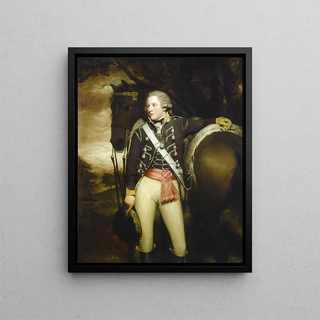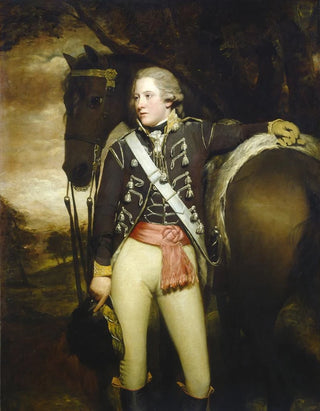Art print | Captain Patrick Miller - Sir Henry Raeburn


View from behind

Frame (optional)
In the vast panorama of art history, some works stand out for their ability to capture the very essence of an era while transcending time. "Captain Patrick Miller" by Sir Henry Raeburn is one of these iconic creations. This painting, created in the early 19th century, offers a fascinating glimpse into the life and values of Scottish society of the time. Through the face of the captain, the artist manages to convey not only an individual identity but also a collective story, that of a country in full transformation. The piece, imbued with dignity, invites the viewer to immerse themselves in a universe where the portrait becomes the mirror of a national identity.
Style and uniqueness of the work
Sir Henry Raeburn's style is often characterized by his mastery of light and shadow, as well as his ability to render textures with remarkable precision. In "Captain Patrick Miller," this approach is highlighted by the choice of rich colors and meticulous details. The captain's face, both serious and thoughtful, seems to emerge from a dark background, emphasizing the depth of his gaze. This chiaroscuro technique, inherited from the great masters of the past, gives the scene a unique emotional intensity. Every element of the painting, from the drape of his uniform to the confident posture of the figure, reveals a story of bravery and determination, while also celebrating the spirit of a time when Scotland sought to assert its place on the international stage.
The artist and his influence
Sir Henry Raeburn, an emblematic figure of Scottish painting, knew how to mark his era with a style that combines realism and romanticism. His artistic journey, marked by success, demonstrates a deep understanding of human psychology. Raeburn was not merely a portraitist; he was a visual storyteller, capable of narrating stories through his subjects. His influence endured long after his lifetime, inspiring many artists who sought to capture the soul of people through portraiture. By highlighting local figures, he also contributed to forging a Scottish cultural identity, paying tribute to characters who, like Patrick Miller, played a crucial role.

Matte finish

View from behind

Frame (optional)
In the vast panorama of art history, some works stand out for their ability to capture the very essence of an era while transcending time. "Captain Patrick Miller" by Sir Henry Raeburn is one of these iconic creations. This painting, created in the early 19th century, offers a fascinating glimpse into the life and values of Scottish society of the time. Through the face of the captain, the artist manages to convey not only an individual identity but also a collective story, that of a country in full transformation. The piece, imbued with dignity, invites the viewer to immerse themselves in a universe where the portrait becomes the mirror of a national identity.
Style and uniqueness of the work
Sir Henry Raeburn's style is often characterized by his mastery of light and shadow, as well as his ability to render textures with remarkable precision. In "Captain Patrick Miller," this approach is highlighted by the choice of rich colors and meticulous details. The captain's face, both serious and thoughtful, seems to emerge from a dark background, emphasizing the depth of his gaze. This chiaroscuro technique, inherited from the great masters of the past, gives the scene a unique emotional intensity. Every element of the painting, from the drape of his uniform to the confident posture of the figure, reveals a story of bravery and determination, while also celebrating the spirit of a time when Scotland sought to assert its place on the international stage.
The artist and his influence
Sir Henry Raeburn, an emblematic figure of Scottish painting, knew how to mark his era with a style that combines realism and romanticism. His artistic journey, marked by success, demonstrates a deep understanding of human psychology. Raeburn was not merely a portraitist; he was a visual storyteller, capable of narrating stories through his subjects. His influence endured long after his lifetime, inspiring many artists who sought to capture the soul of people through portraiture. By highlighting local figures, he also contributed to forging a Scottish cultural identity, paying tribute to characters who, like Patrick Miller, played a crucial role.






